Potential of Fish Habitat Resilience Under Hydrodynamic Regulation of a Plain Urban River Network in Shanghai City, China
Abstract
1. Introduction
2. Materials and Methods
2.1. Study Area
2.2. Water Diversion, Monitoring Programs and Data Collection
2.3. Evaluation Model for Fish Habitat Restoration Potential
2.3.1. Indicator Species
2.3.2. Survey of Key Habitat Factors
2.3.3. Hydrodynamic Model
2.3.4. Evaluation Model for Fish Habitat Resilience Potential Based on Fish Habitat Suitability
3. Results
3.1. Habitat Characteristics and Water Quality Changes with Water Diversion
3.2. Fish Habitat Restoration Potential Resilience (HRPI) with Water Diversion
4. Discussion
4.1. Feasibility of Improving Fish Habitat Resilience Potential Under Hydrodynamic Regulation
4.2. River Habitat Restoration Potential Evaluation Model Feedback
5. Conclusions
Author Contributions
Funding
Data Availability Statement
Conflicts of Interest
Appendix A
| Type | Index | Range of Study Area | Ecological Significance |
|---|---|---|---|
| Hydrological | velocity (m/s) | 0–2 m/s | It can affect the concentration of nutrients in the water body, stimulate the swimming and route of migratory fish, and provide suitable conditions for floating fish eggs to hatch downstream. |
| depth (m) | 0–25 m | Water depth provides a suitable moving space for bottom-dwelling fish and a hatching environment for sinking eggs. | |
| River morphology | substrate | rock or hard channels | One of the sources of nutrients needed by aquatic animals; the distribution of bottom-dwelling locations and spawning grounds that fish species choose are impacted of substrate styles. |
| Water quality | DO (mg/L) | 0.6–8 mg/L | Breathing and feeding activities are reduced and, at the same time, immunity, growth, and metabolism activities are affected by hypoxic stress of fish when the DO content in the river is too low. However, bubble disease in fish will be caused by a DO concentration that is too high. |
| NH3-N (mg/L) | 0.8–4.5 mg/L | Fish species poisoning will take place, their respiratory function will be inhibited, and their nerve centers will be damaged, which is manifested by a significant reduction in food intake. Moreover, their immune function will be impaired, various abnormal physiological and biochemical indicators will be shown, and the fish will die. | |
| Habitat Type | Used Type | Urbanization Level | Discharge | ||||
|---|---|---|---|---|---|---|---|
| Stream segment: | (Shipping) | □ | Very low | □ | Very low | □ | |
| Beginning coordinate: | Electricity | □ | Low | □ | Low | □ | |
| Ending coordinate: | Water supply | □ | Low to moderate | □ | Low to moderate | □ | |
| Fishway: | Moderate | □ | Moderate | □ | |||
| Yes | Moderate to high | □ | Moderate to high | □ | |||
| No | Very high | □ | Very high | □ | |||
| DO (mg/L) | CODMn (mg/L) | NH3-N (mg/L) | TP (mg/L) | ||||
| ≥7.5 | □ | ≤2 | □ | ≤0.15 | □ | ≤0.02 | □ |
| 6–7.5 | □ | 2–4 | □ | 0.15–0.5 | □ | 0.02–0.1 | □ |
| 5–6 | □ | 4–6 | □ | 0.5–1 | □ | 0.1–0.2 | □ |
| 3–5 | □ | 6–10 | □ | 1–1.5 | □ | 0.2–0.3 | □ |
| 2–3 | □ | 10–15 | □ | 1.5–2 | □ | 0.3–0.4 | □ |
| <2 | □ | >15 | □ | >2 | □ | >0.4 | □ |
| Depth | Velocity | Substrate | |||||
| 0–30 cm | □ | 0–10 cm/s | □ | Mucky clay, <0.063 mm | □ | ||
| 20–50 cm | □ | 10–30 cm/s | □ | Silt, 0.063–2.0 mm | □ | ||
| 40–70 cm | □ | 20–50 cm/s | □ | Small gravel, 2.0–6.0 mm | □ | ||
| 60–120 cm | □ | 40–70 cm/s | □ | Moderate gravel, 6.0–20.0 mm | □ | ||
| 100–200 cm | □ | >70 cm/s | □ | Big graval, 2.0–6.0 cm | □ | ||
| >200 cm | □ | Big cobblestone, 12.0–20 cm Boulder, >20.0 cm Rock or hard channel | □ | ||||
| Porosity filling | Suspended solids | ||||||
| 1 | 1 | ||||||
| 2 | 2 | ||||||
| 3 | 3 | ||||||
| 4 | 4 | ||||||
| 5 | 5 | ||||||
| Riparian vegetation: | Riverbank type: | ||||||
| Coverage rates are higher than 80% and more than 5 plant types | Cement channel | ||||||
| The planting coverage rate is between 60~80%, and there are 4 or 5 plant types | Stone assembled | ||||||
| The planting coverage rate is between 40~60%, and there are 3 or 4 plant types | Vegetation | ||||||
| The planting coverage rate is between 20~40%, and there are 2 or 3 plant types | Nature | ||||||
| The penetration rate is less than 20% and there was only a uniform plant type | Mucky clay | ||||||
References
- Dong, Z.R. River Restoration; China Water & Power Press: Beijing, China, 2003. [Google Scholar]
- Song, Q.; Yang, Z. Thinking of integrated management of urban rivers in China. Adv. Water Sci. 2002, 13, 377–382. (In Chinese) [Google Scholar]
- Yang, S.H. Urban Ecological Environment; Science Press: Beijing, China, 2003. [Google Scholar]
- Dynesius, M.; Nilsson, C. Fragmentation and flow regulation of river systems in the Northern Third of the World. Science 1994, 266, 753–762. [Google Scholar] [CrossRef] [PubMed]
- Maddock, I. The importance of physical habitat assessment for evaluating river health. Freshw. Biol. 2010, 41, 373–391. [Google Scholar] [CrossRef]
- Fang, Y.P.; Wang, M.J.; Deng, W.; Xu, K.Y. Exploitation scale of hydropower based on instream flow requirements: A case from southwest China. Renew. Sustain. Energy Rev. 2010, 14, 2290–2297. [Google Scholar] [CrossRef]
- Luo, Z.; Zuo, Q.; Shao, Q. A new framework for assessing river ecosystem health with consideration of human service demand. Sci. Total Environ. 2018, 640–641, 442–453. [Google Scholar] [CrossRef]
- Guan, Y.Q.; Chen, Y.; Zhang, D.R.; Du, X.X.; Tian, X.Z.; Chen, Y.Z. Aquatic environmental simulation and pollutant load calculation in plain river networks. Water Resour. Prot. 2016, 32, 111–118. (In Chinese) [Google Scholar]
- Song, S.; Xu, Y.P.; Zhang, J.X.; Li, G.; Wang, Y.F. The long-term water level dynamics during urbanization in plain catchment in Yangtze River Delta. Agric. Water Manag. 2016, 174, 93–102. [Google Scholar] [CrossRef]
- Pan, H.Z.; Li, Y.P.; Tang, C.Y.; Acharya, K.; Yao, X.Y.; Zhang, J.; Zhu, Y.; Chen, Y.X.; Chen, Y.; Yu, S. Evaluation of the effect of water diversion on improving water environment in plain river network under the multi-objective optimization. J. Lake Sci. 2021, 33, 15. (In Chinese) [Google Scholar]
- Yan, Y.; Yuan, S.Y.; Tang, H.W.; Lyu, S.Q.; Lei, Y.; Li, Y. Hydrodynamic reconstruction of wennan river network in Shanghai city. J. Hohai Univ. (Nat. Sci.) 2021, 49, 329–334+365. (In Chinese) [Google Scholar]
- Zeng, Y.S.; Bi, C.J.; Jia, J.P.; Deng, L.; Chen, Z.L. Impact of intensive land use on heavy metal concentrations and ecological risks in an urbanized river network of Shanghai. Ecol. Indic. 2020, 116, 106501. [Google Scholar] [CrossRef]
- Bernhardt, E.S.; Palmer, M.A.; Allan, J.D.; Alexander, G.; Barnas, K.; Brooks, S. Synthesizing, U.S. River Restoration Efforts. Science 2005, 308, 636–637. [Google Scholar] [CrossRef] [PubMed]
- Grill, G.; Lehner, B.; Thieme, M.; Geenen, B.; Tickner, D.; Antonelli, F.; Babu, S.; Borrelli, P.; Cheng, L.; Crochetiere, H.; et al. Mapping the world’s free-flowing rivers. Nature 2019, 569, 215–221. [Google Scholar] [CrossRef]
- Deng, X. Correlations between water quality and the structure and connectivity of the river network in the Southern Jiangsu Plain, Eastern China. Sci. Total Environ. 2019, 664, 583–594. [Google Scholar] [CrossRef] [PubMed]
- Cui, G.B.; Chen, X.; Xiang, L.; Zhang, Q.C.; Xu, Q. Evaluation of water environment improvement by interconnected river network in plain area. J. Hydraul. Eng. 2017, 48, 1429–1437. (In Chinese) [Google Scholar]
- Deng, X.J. Influence of water body area on water quality in the southern Jiangsu Plain, eastern China. J. Clean. Prod. 2020, 254, 120136. [Google Scholar] [CrossRef]
- Wang, T.; Wang, J.; Lei, Q.; Zhao, Y.; Wang, L.; Wang, X.; Zhang, W. Microplastic pollution in sophisticated urban river systems: Combined influence of land-use types and physicochemical characteristics. Environ. Pollut. 2021, 287, 117604. [Google Scholar] [CrossRef]
- Yin, H.; Islam, M.S.; Ju, M. Urban river pollution in the densely populated city of Dhaka, Bangladesh: Big picture and rehabilitation experience from other developing countries. J. Clean. Prod. 2021, 321, 129040. [Google Scholar] [CrossRef]
- McKinney, M.L. Effects of urbanization on species richness: A review of plants and animals. Urban Ecosyst. 2008, 11, 161–176. [Google Scholar] [CrossRef]
- Mulholland, P.J.; Houser, J.N.; Maloney, K.O. Stream diurnal dissolved oxygen profiles as indicators of in-stream metabolism and disturbance effects: Fort Benning as a case study. Ecol. Indic. 2005, 5, 243–252. [Google Scholar] [CrossRef]
- Lu, X.C.; Li, Y.P.; Huang, D.J.; Zhou, D.; He, M.J.; Jiang, W.B. Study on water diversion schemes for improvement of hydrodynamics in plain river network. Water Resour. Power 2015, 33, 93–95+138. (In Chinese) [Google Scholar]
- Hwang, J.Y.; Kim, Y.D.; Kwon, J.H.; Park, J.H.; Noh, J.W.; Yi, Y.K. Hydrodynamic and water quality modeling for gate operation: A case study for the Seonakdong River basin in Korea. KSCE J. Civ. Eng. 2013, 18, 73–80. [Google Scholar] [CrossRef]
- Gallardo, B.; Aldridge, D.C. Inter-basin water transfers and the expansion of aquatic invasive species. Water Res. 2018, 143, 282–291. [Google Scholar] [CrossRef] [PubMed]
- Li, Y.P.; Acharya, K.; Yu, Z.B. Modeling impacts of Yangtze River water transfer on water ages in Lake Taihu, China. Ecol. Eng. 2011, 37, 325–334. [Google Scholar] [CrossRef]
- Du, J.; Chen, H.H.; Chen, Z.H.; Chen, D.W. Water diversion and control for water environment in tidal network of Pearl river delta. J. China Hydrol. 2012, 32, 16–21. (In Chinese) [Google Scholar]
- Xia, K.; Wang, H.; Qin, W.H.; Qian, J. Assessment on effects of water quality improvement in inner Qinhuai River by water dispatching. Water Resour. Prot. 2015, 31, 74–78+110. (In Chinese) [Google Scholar]
- Yu, S.; Li, Y.P.; Cheng, Y.X.; Shi, Y.Y.; Cheng, Y.; Huang, Y.N.; Zhu, Y.; Pan, H.Z.; Yue, Z.W.; Zheng, K. The impacts of water diversion on hydrodynamic regulation of plain river network. J. Lake Sci. 2021, 33, 462–473. (In Chinese) [Google Scholar]
- Liu, Z.Q.; Wang, H.; Feng, X.Y.; Yan, H.Y.; Xia, K. Values of plain river network hydraulic regulatory threshold based on water quality objectives. Environ. Sci. Technol. 2021, 44, 200–210. (In Chinese) [Google Scholar]
- Tan, P.Y. The Study on Real-Time Optimization of Water Diversion Project Scheme in Lowland River Based on the Varation of Dissolved Ocugen. Ph.D. Thesis, Zhejiang University, Hangzhou, China, 2020. (In Chinese). [Google Scholar]
- Zuo, Q.; Chen, H.; Dou, M.; Zhang, Y.; Li, D. Experimental analysis of the impact of sluice regulation on water quality in the highly polluted Huai River Basin, China. Environ. Monit. Assess. 2015, 187, 450. [Google Scholar] [CrossRef]
- Zhang, Q.; Chen, Y.D.; Jiang, T.; Chen, X.; Liu, Z. Human-induced regulations of river channels and implications for hydrological alterations in the Pearl River Delta, China. Stoch. Environ. Res. Risk Assess. 2011, 25, 1001–1011. [Google Scholar] [CrossRef]
- Tena, A.; Vericat, D.; Gonzalo, L.E.; Batalla, R.J. Spatial and temporal dynamics of macrophyte cover in a large regulated river. J. Environ. Manag. 2017, 202, 379–391. [Google Scholar] [CrossRef]
- Baruah, A.; Sarma, A.K.; Hinge, G. Hydrological–Hydrodynamic Nexus for Evaluation of Fish Habitat Suitability in the Bhogdoi River, India. J. Hydrol. Eng. 2021, 26, 04021032. [Google Scholar] [CrossRef]
- Lavelle, A.M.; Chadwick, M.A.; Chadwick, D.D.A.; Pritchard, E.G.; Bury, N.R. Effects of Habitat Restoration on Fish Communities in Urban Streams. Water 2021, 13, 2170. [Google Scholar] [CrossRef]
- Holling, S.C. Resilience and Stability of Ecological Systems. Annu. Rev. Ecol. Syst. 1973, 4, 1–23. [Google Scholar] [CrossRef]
- Fuller, I.C.; Gilvear, D.J.; Thoms, M.C.; Death, R.G. Framing resilience for river geomorphology: Reinventing the wheel? River Res. Appl. 2019, 35, 91–106. [Google Scholar] [CrossRef]
- Qi, M.; Feng, M.L.; Sun, T.; Yang, W. Resilience changes in watershed systems: A new perspective to quantify long-term hydrological shifts under perturbations. J. Hydrol. 2016, 539, 281–289. [Google Scholar] [CrossRef]
- Bouska, K.L.; Houser, J.N.; De Jager, N.R.; Van Appledorn, M.; Rogala, J.T. Applying concepts of general resilience to large river ecosystems: A case study from the Upper Mississippi and Illinois rivers. Ecol. Indic. 2019, 101, 1094–1110. [Google Scholar] [CrossRef]
- Fausch, K.D.; Torgersen, C.E.; Baxter, C.V.; Li, H.W. Landscapes to Riverscapes: Bridging the Gap between Research and Conservation of Stream Fishes. BioScience 2002, 52, 483–498. [Google Scholar] [CrossRef]
- Marchetti, M.P. Ecology of North American freshwater fishes. Freshw. Sci. 2014, 33, 374–375. [Google Scholar] [CrossRef]
- Mamdani, E.H. Application of fuzzy algorithms for control of simple dynamic plant. Proc. Inst. Electr. Eng. 1974, 121, 1585–1588. [Google Scholar] [CrossRef]
- Bellmore, J.R.; Baxter, C.V.; Ray, A.M.; Denny, L.; Tardy, K.; Galloway, E. Assessing the potential for salmon recovery via floodplain restoration: A multitrophic level comparison of dredge-mined to reference segments. Environ. Manag. 2012, 49, 734–750. [Google Scholar] [CrossRef]
- Whitley, S.N.; Bollens, S.M. Fish assemblages across a vegetation gradient in a restoring tidal freshwater wetland: Diets and potential for resource competition. Environ. Biol. Fishes 2013, 97, 659–674. [Google Scholar] [CrossRef]
- Zaky, M.M.M.; Salem, M.A.M.; Persson, K.M.M.; Eslamian, S.S. Incidence of Aeromonas species isolated from water and fish sources of Lake Manzala in Egypt. Int. J. Hydrol. Sci. Technol. 2011, 1, 47–62. [Google Scholar] [CrossRef]
- Hughes, S.J.; Santos, J.; Ferreira, T.; Mendes, A. Evaluating the response of biological assemblages as potential indicators for restoration measures in an intermittent Mediterranean river. Environ. Manag. 2010, 46, 285–301. [Google Scholar] [CrossRef] [PubMed]
- Zhao, C.S.; Yang, S.T.; Xiang, H.; Liu, C.M.; Zhang, H.T.; Yang, Z.L.; Zhang, Y.; Sun, Y.; Mitrovic, S.M.; Yu, Q.; et al. Hydrologic and water-quality rehabilitation of environments for suitable fish habitat. J. Hydrol. 2015, 530, 799–814. [Google Scholar] [CrossRef]
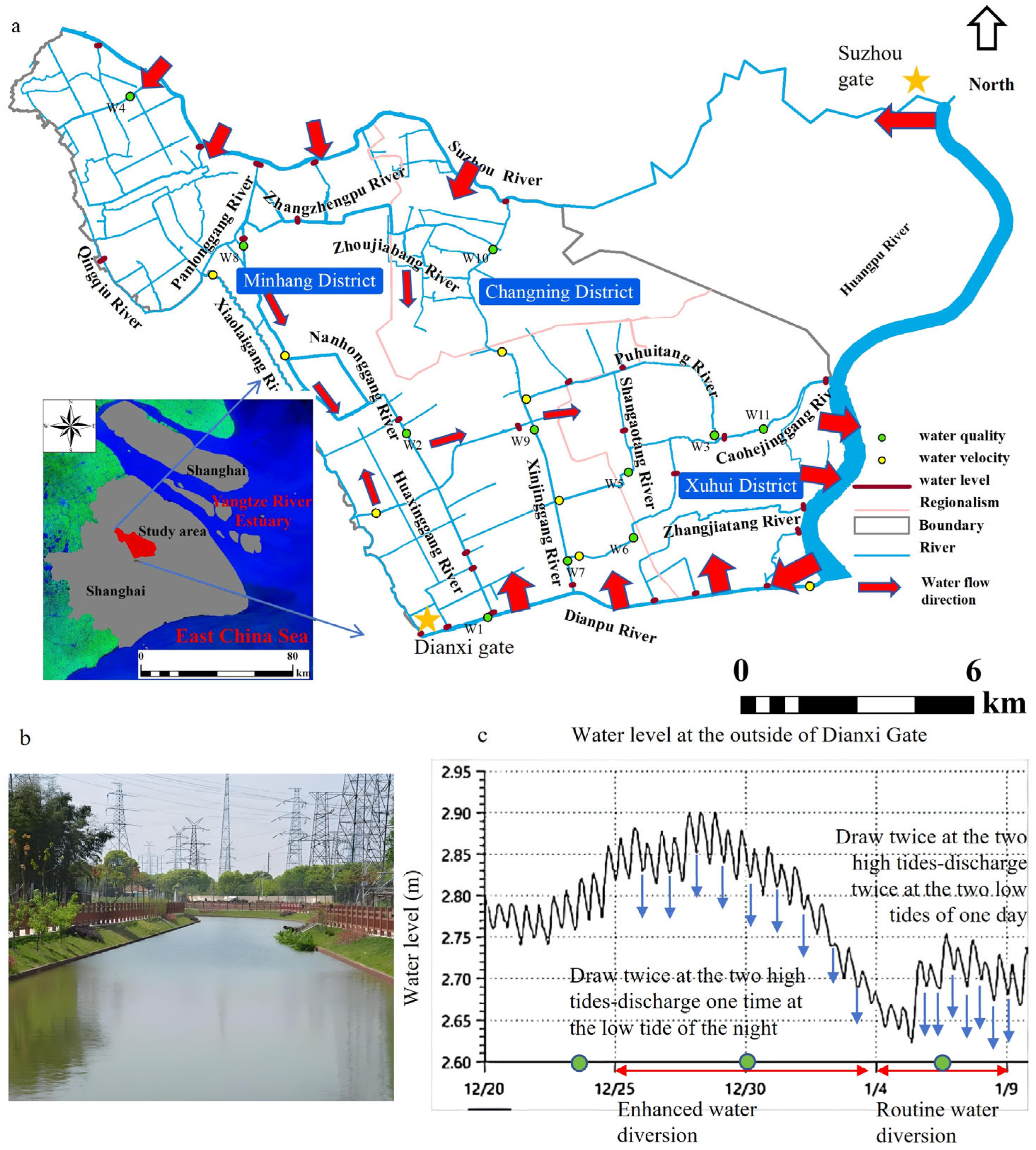
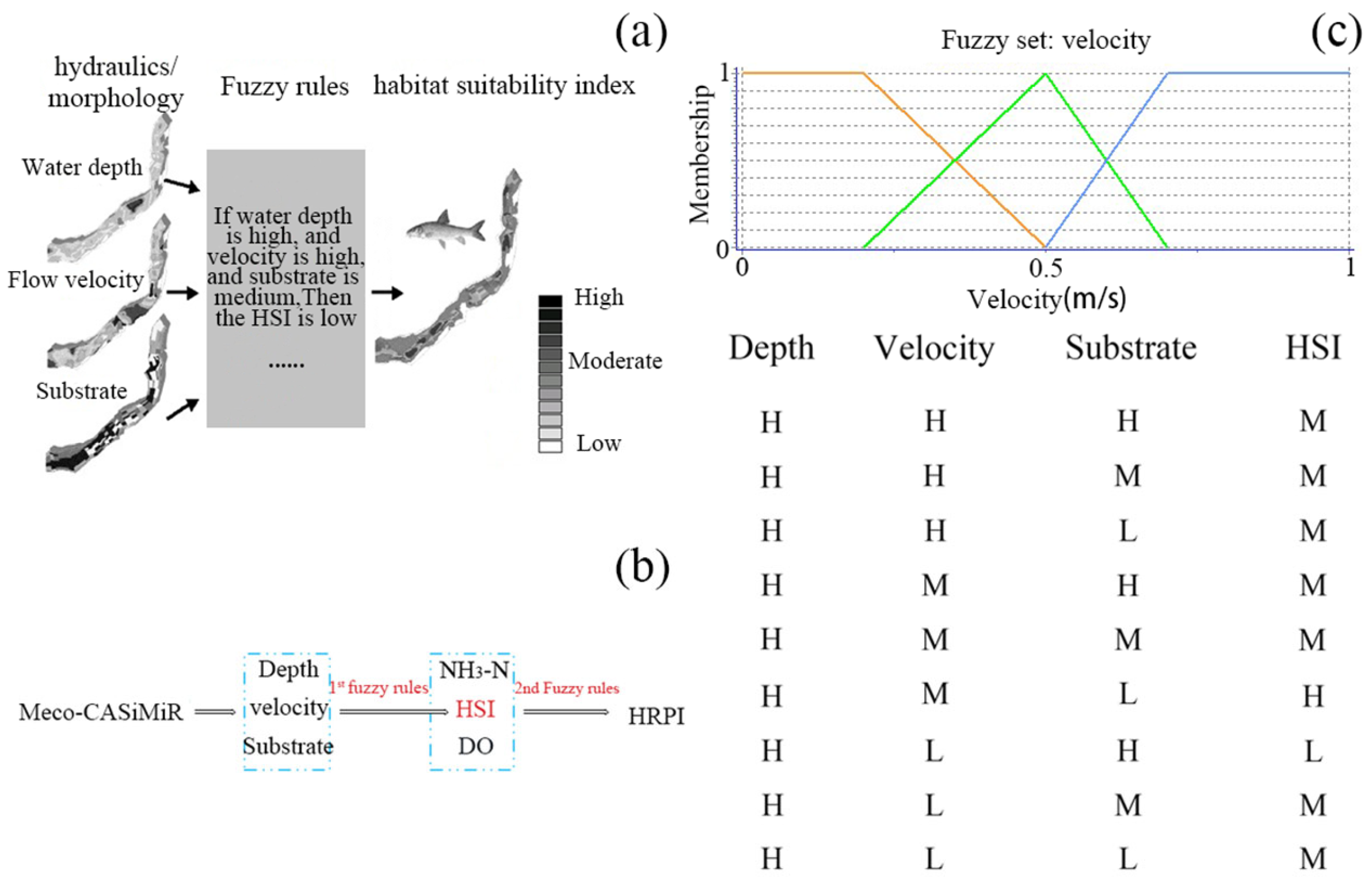
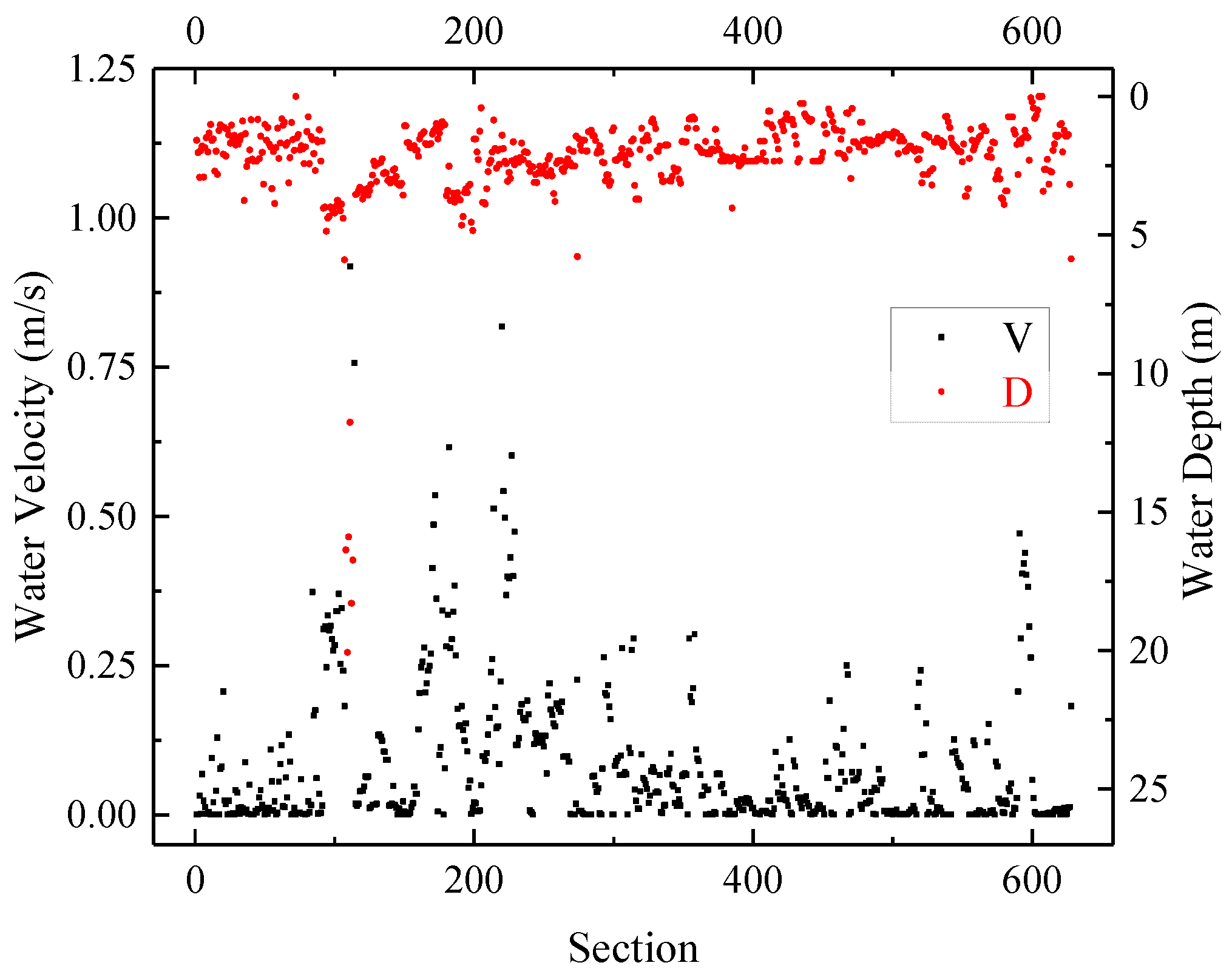

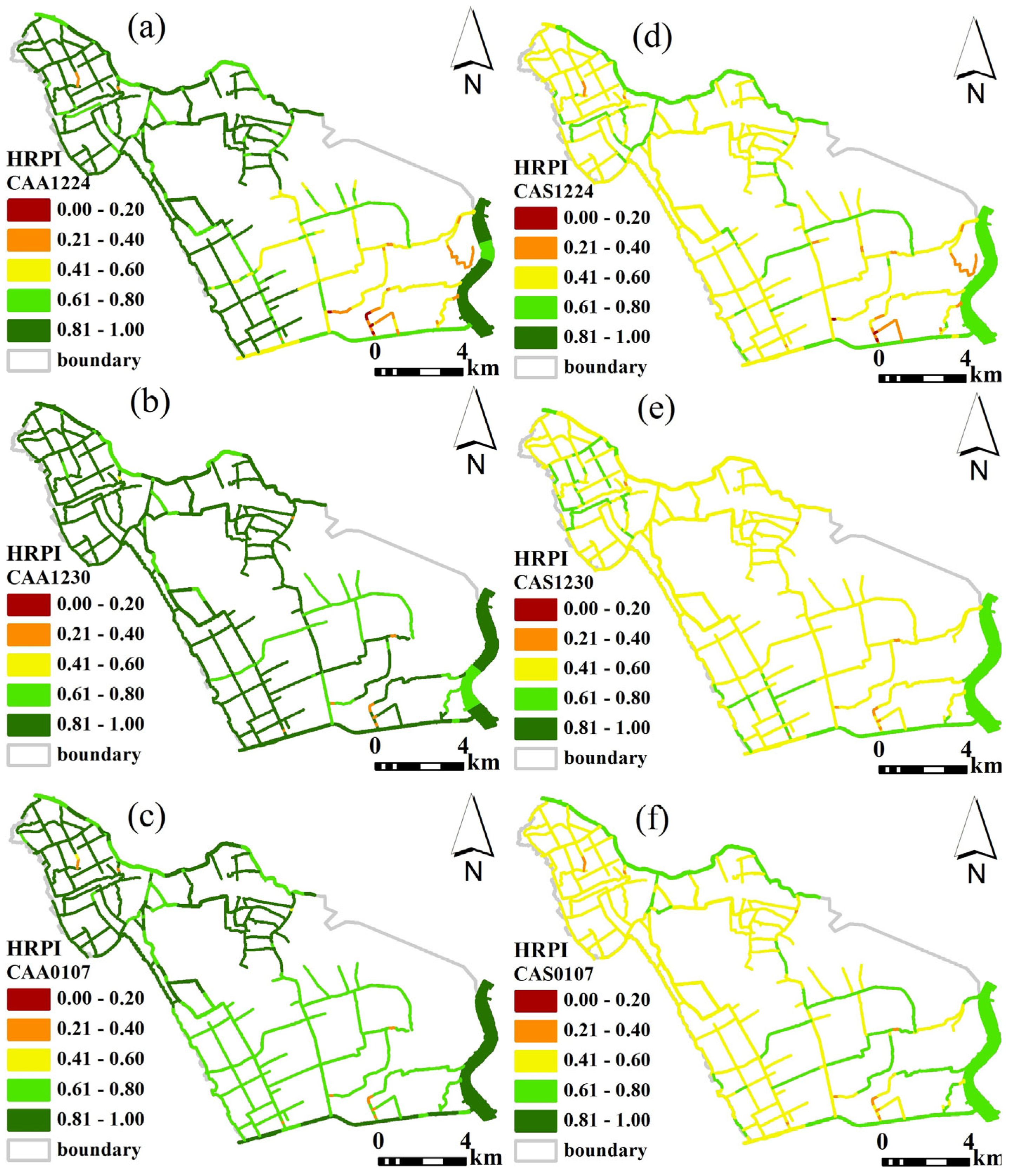
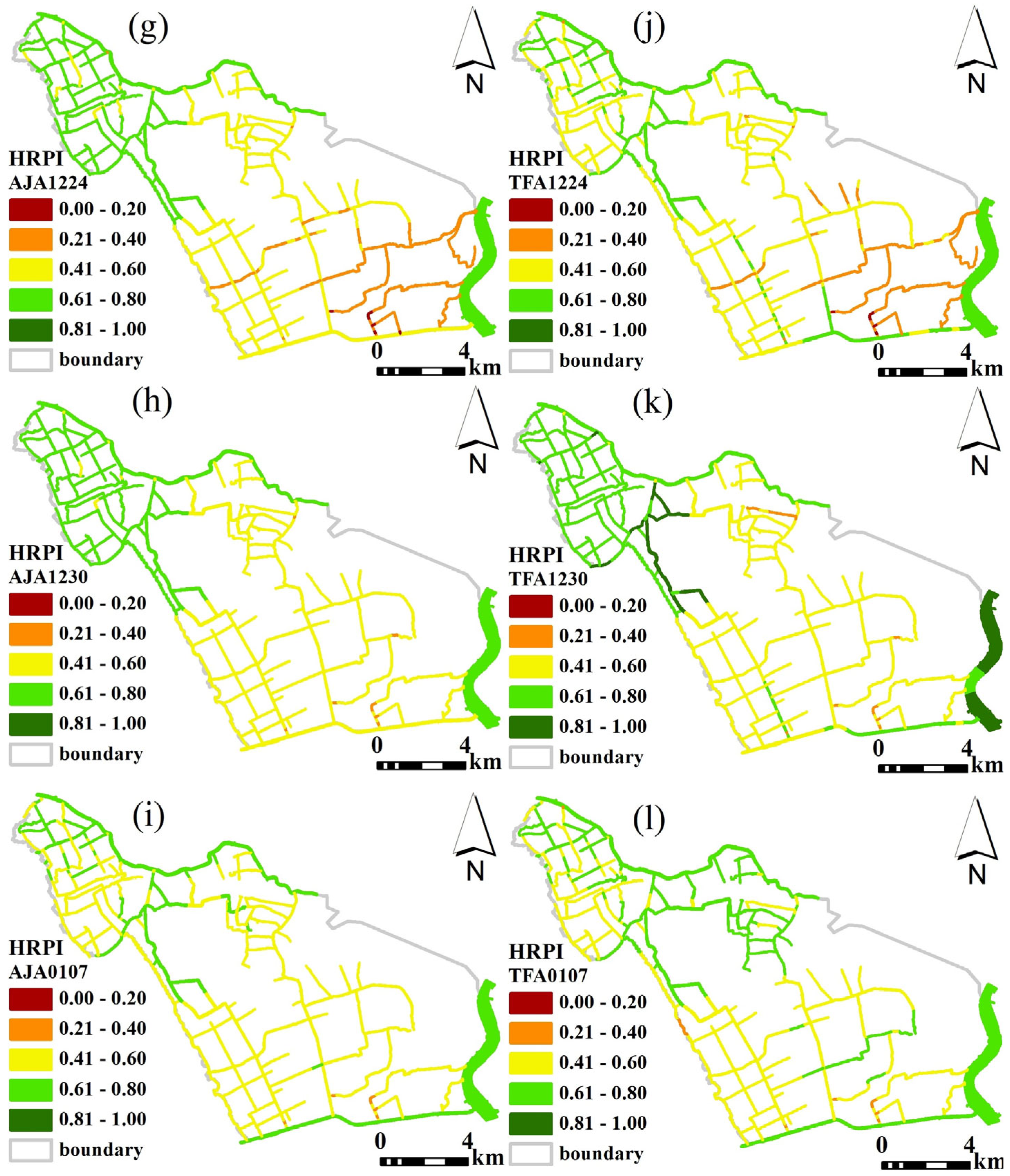
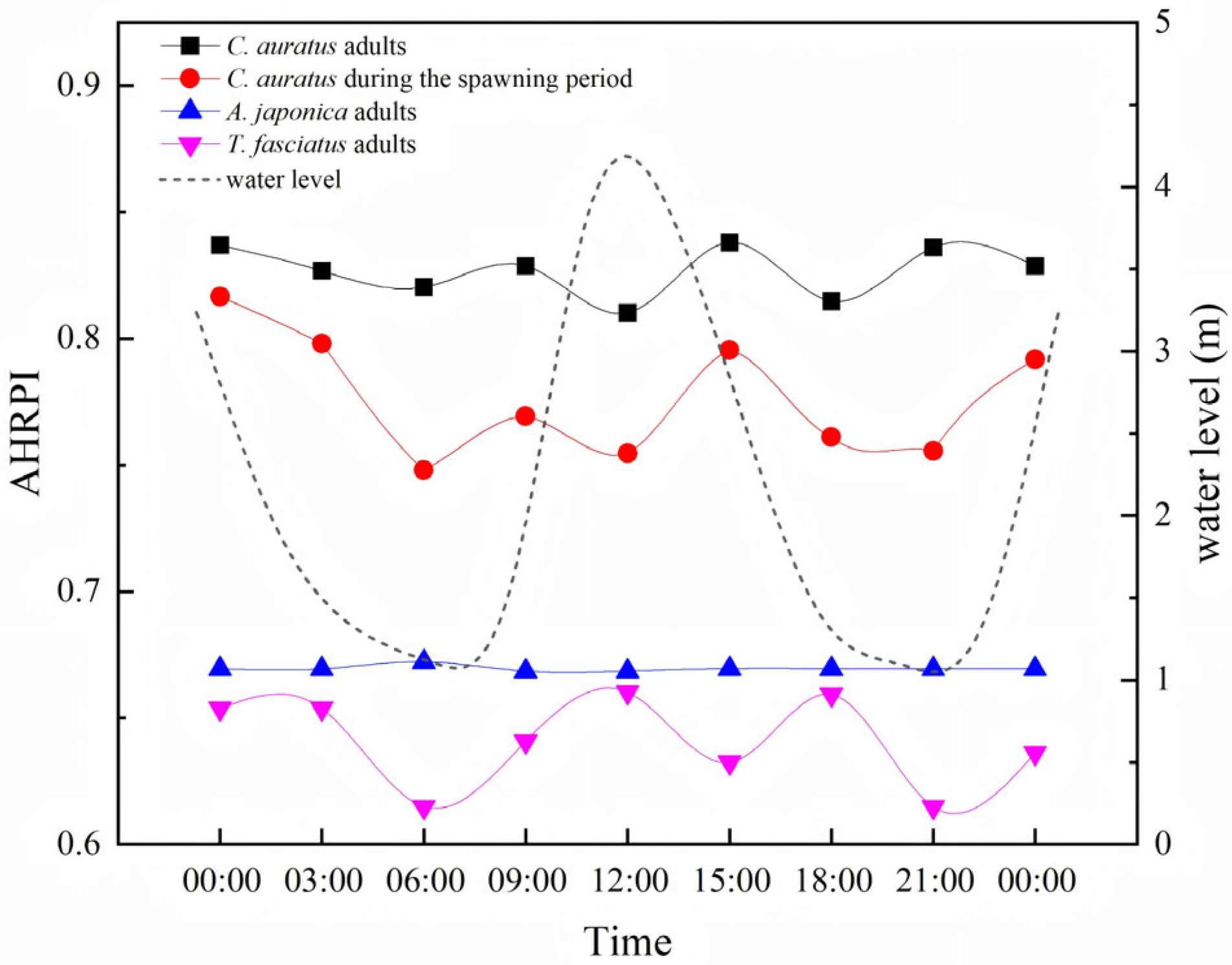
| Date | CAA | CAS | AJA | TFA |
|---|---|---|---|---|
| 24 December 2015 | 0.6759 | 0.5389 | 0.5172 | 0.5269 |
| 30 December 2015 | 0.7709 | 0.5221 | 0.5505 | 0.5645 |
| 7 January 2016 | 0.7455 | 0.5440 | 0.5650 | 0.5938 |
| Hydrodynamic Factors as the Control Variable | Water Quality as the Control Variable | |||||||
|---|---|---|---|---|---|---|---|---|
| CAA | CAS | AJA | TFA | CAA | CAS | AJA | TFA | |
| 24 December 2015 | 0.6759 | 0.5389 | 0.5172 | 0.5269 | 0.6759 | 0.5389 | 0.5172 | 0.5269 |
| 30 December 2015 | 0.7610 | 0.4727 | 0.5494 | 0.5678 | 0.7154 | 0.4489 | 0.5190 | 0.5113 |
| 7 January 2016 | 0.7416 | 0.4346 | 0.5673 | 0.6030 | 0.7142 | 0.4833 | 0.5144 | 0.5171 |
Disclaimer/Publisher’s Note: The statements, opinions and data contained in all publications are solely those of the individual author(s) and contributor(s) and not of MDPI and/or the editor(s). MDPI and/or the editor(s) disclaim responsibility for any injury to people or property resulting from any ideas, methods, instructions or products referred to in the content. |
© 2025 by the authors. Licensee MDPI, Basel, Switzerland. This article is an open access article distributed under the terms and conditions of the Creative Commons Attribution (CC BY) license (https://creativecommons.org/licenses/by/4.0/).
Share and Cite
Zhang, J.; Luan, T.; Wang, X.; Xie, C.; Ji, B.; Sun, D.; Sun, G.; Yi, Q. Potential of Fish Habitat Resilience Under Hydrodynamic Regulation of a Plain Urban River Network in Shanghai City, China. Water 2025, 17, 817. https://doi.org/10.3390/w17060817
Zhang J, Luan T, Wang X, Xie C, Ji B, Sun D, Sun G, Yi Q. Potential of Fish Habitat Resilience Under Hydrodynamic Regulation of a Plain Urban River Network in Shanghai City, China. Water. 2025; 17(6):817. https://doi.org/10.3390/w17060817
Chicago/Turabian StyleZhang, Jin, Tingting Luan, Xiaoyun Wang, Chen Xie, Bin Ji, Dexin Sun, Guanghui Sun, and Qitao Yi. 2025. "Potential of Fish Habitat Resilience Under Hydrodynamic Regulation of a Plain Urban River Network in Shanghai City, China" Water 17, no. 6: 817. https://doi.org/10.3390/w17060817
APA StyleZhang, J., Luan, T., Wang, X., Xie, C., Ji, B., Sun, D., Sun, G., & Yi, Q. (2025). Potential of Fish Habitat Resilience Under Hydrodynamic Regulation of a Plain Urban River Network in Shanghai City, China. Water, 17(6), 817. https://doi.org/10.3390/w17060817





